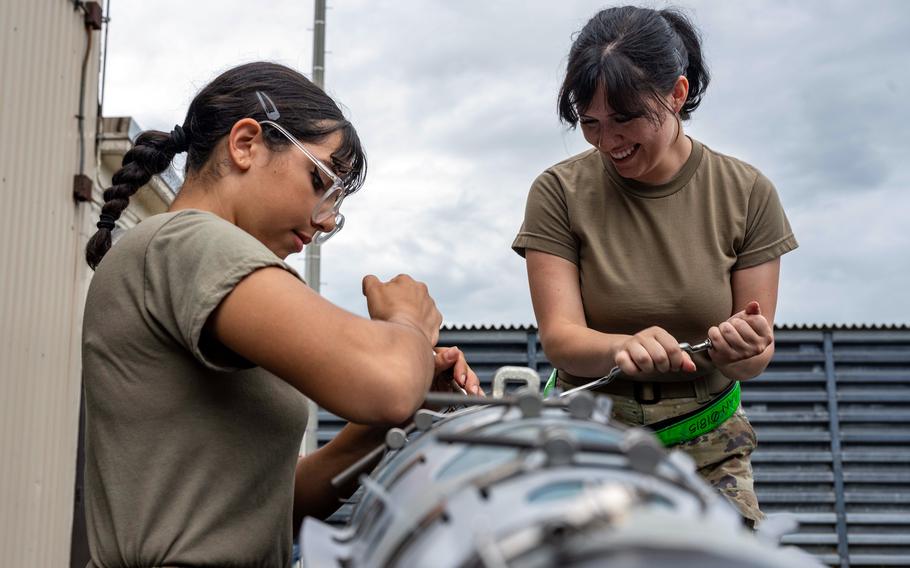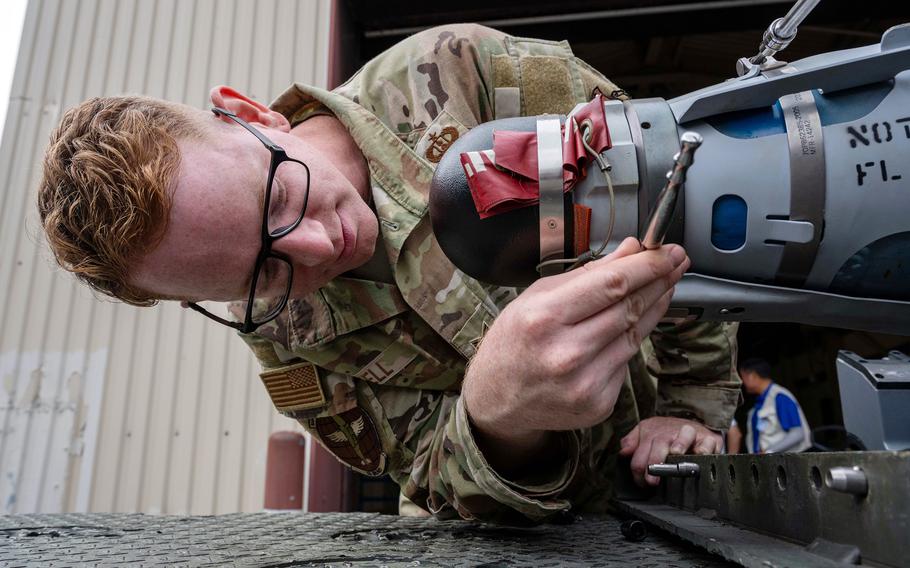
Airman 1st Class Zayra Perez, left, and Senior Airman Makayla Killian, both of the 35th Munitions Squadron, disassemble a bomb during training at Misawa Air Base, Japan, Aug. 7, 2025. (Andre Medina/U.S. Air Force)
On an Air Force base in northern Japan, a newly formed squadron of bomb builders has begun assembling munitions in anticipation of a new era in regional airpower.
Activated on June 17, the 35th Munitions Squadron is composed of 225 airmen who were previously assigned to Misawa Air Base’s maintenance squadron.
Known informally as “the Tanukis,” a reference to Japan’s wild racoon dogs, the unit is preparing for the arrival of F-35A Lightning II stealth fighters, part of a larger modernization effort by the U.S. military across Japan.
The new squadron reflects Misawa’s growing role as a strategic hub for fifth-generation aircraft and deepens the integration between U.S. and Japanese forces stationed there. The Japan Air Self-Defense Force, which shares the base with its American counterparts, has operated its own fleet of F-35As at Misawa since 2018.

Staff Sgt. William Powell, of the 35th Munitions Squadron, disassembles a bomb during training at Misawa Air Base, Japan, Aug. 7, 2025. (Andre Medina/U.S. Air Force)
Last year, the Pentagon announced plans to deploy 48 F-35As to Misawa, replacing 36 F-16 Fighting Falcons stationed there. An unspecified number of F-16s relocated from Misawa to Osan Air Base, South Korea in late June, Osan’s 51st Fighter Wing said at the time.
Japanese government officials have said the stealth jets are expected to arrive in spring.
Capt. Angel Valles, the munitions squadron’s operations director, expressed hope that the F-35 deployment would allow for closer collaboration with Japanese bomb builders.
“The Japanese have their own munitions team,” he told Stars and Stripes in a phone interview Thursday alongside several of his team members. “We are hoping that when the F-35s arrive we can integrate more with them.”
Valles envisions a future in which American and Japanese forces could share responsibilities for building and maintaining each other’s weaponry.
“We want to get to the point where we can build munitions for [Japanese] aircraft and they can build munitions for ours,” he said.
The stealth fighters’ deployment to Misawa is part of a sweeping U.S. force realignment in Japan, which also includes the stationing of F-15EX Eagles on Okinawa and the replacement of Navy F/A-18 Super Hornets with F-35Cs at Marine Corps Air Station Iwakuni.
In a statement released July 3, 2024, the Defense Department said the plan — coordinated with the Japanese government — represents more than $10 billion in capability investments designed to enhance the U.S.-Japan alliance, strengthen deterrence, and promote peace and stability in the Indo-Pacific region.
The move comes as the United States refines its military posture in response to China, which was identified in the Pentagon’s 2022 National Defense Strategy as a “pacing challenge” due to its assertive presence in the East and South China Seas.
“The Department’s plan to station the Joint Force’s most advanced tactical aircraft in Japan demonstrates the ironclad U.S. commitment to the defense of Japan and both countries’ shared vision of a free and open Indo-Pacific region,” the Pentagon said in its statement.
At the ground level, the airmen of the 35th Munitions Squadron are already working to meet the demands of the future. From 5.56 mm rounds to 2,000-pound bombs, the squadron is responsible for producing and maintaining a wide range of weaponry, Tech. Sgt. Julia Danke-Garcia, a unit section chief, said in Thursday’s phone interview.
But the arrival of the F-35s will likely change how they operate, said 1st Lt. Cole Petresu-Boboc, a munitions production leader.
“Until the F-35s get here we won’t know or fully understand what that means,” he said. “We are just prepared for when they get here.”
Part of that preparation includes training for agile combat employment, or ACE, a key Air Force doctrine that emphasizes rapid dispersal of aircraft to a network of smaller airfields, making them harder to target in a potential conflict.
For bomb builders, this means being able to operate in austere environments.
Over the past two weeks, 16 airmen and two trainers have been assembling and disassembling satellite-guided bombs at Misawa under field-like conditions — a rehearsal for the types of challenges they may face in the real world.
“You can take a four-man crew and put them on a remote island with a trailer and tools, and they can build munitions and load them on aircraft,” Petresu-Boboc said.